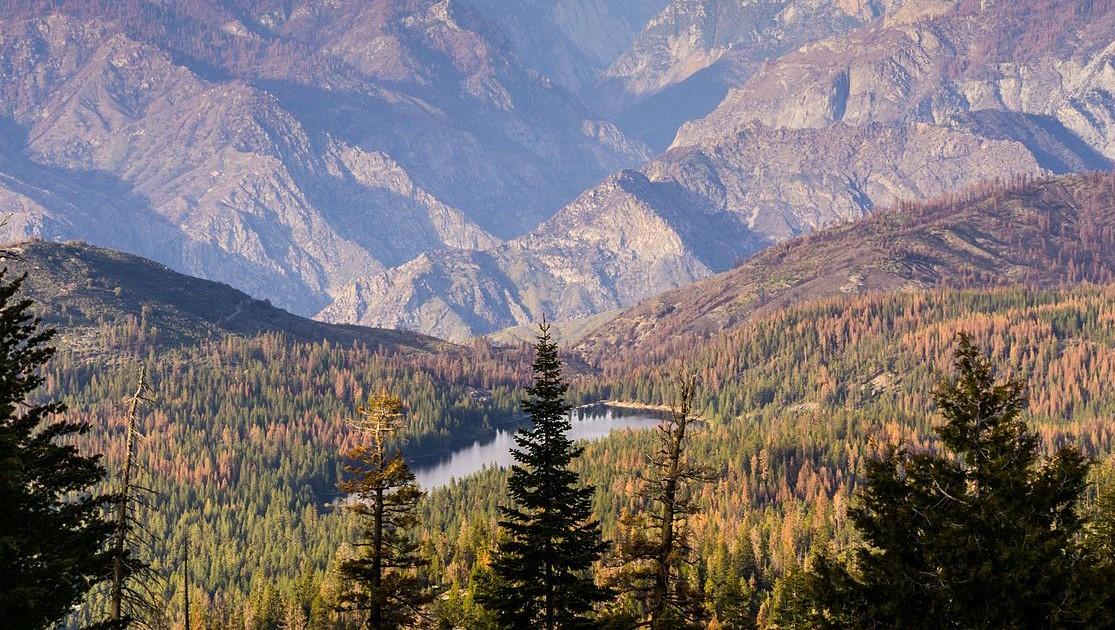How can we save California’s forests?
This vista shows damage by mountain pine beetles to the forests surrounding Hume Lake in California as of April 2016.
To say trees in California are having a tough time may be an understatement. Years of drought conditions and warmer temperatures have stressed millions of trees, and surging numbers of bark beetles, the rice-grain size invaders that attack tree bark, are dealing a death blow.
The US Forest Service estimates that 66 million trees are already dead in the state, and the siege drags on. But to slow the wave of tree death from these outside assailants, scientists are looking close to home for answers: to the trees themselves.
Christina Restaino, a research scientist at the University of California, Davis, says after years of fire suppression, California’s forests are overcrowded. That crowding, plus drought and temperatures warm enough for bark beetles to reproduce all winter, has put the forest’s natural cycles out of whack.
“Unfortunately, what is happening is that these trees are overwhelmed by the combination of the water stress and the beetle outbreak,” Restaino says. “We have this overcrowding of the forest. There are too many straws in the cup.”
In drought conditions, trees have a harder time fighting off bark beetles because they make less sap. Sap can push beetles out of a tree's bark (they drown in it), but producing the stuff is a low priority for trees that are trying to compensate for lost water.
“Trees will first invest in their roots in order to get more water,” Restaino says. “They will then invest in their leaves so that they produce more of the factories that help them grow. They will then try to get taller, and then to reach more light, then they will try to get wider. And then after that, they can invest in sap.”
And trees that are desperate for water also resort to a natural "belt-tightening" tactic that may attract more beetles. According to Restaino, when a tree’s roots sense that the ground is dry, they send a chemical signal telling the tree to release a gas into its trunk.
“By doing this, it reduces the overall content of water in the tree and tricks the tree to pull more water from the roots,” she says. “That gas is a pheromone that attracts the bark beetles.”
Greg Asner, an ecologist with the Carnegie Institution for Science as Stanford, is mapping sick trees across California, mostly from the air — in a plane that's outfitted with high-powered aerial imaging technology. Using a technique called laser-guided spectroscopy, Asner’s team can create 3-D chemical models of a forest’s canopy, measuring up to 20 different chemical traits of trees as the plane flies over them.
“What we're able to do is see inside the tree canopy, the foliage of the tree, and tell you how much water is in the tree, how much sugar and starch — we call that carbohydrates — and how much nitrogen is in the tree,” Asner says.
By using tree chemistry to evaluate the health of forests, Asner’s team can predict which trees will succumb to drought and beetles up to a year before they actually die. Lately, he says, California’s sugar pine and ponderosa pine have been hit the hardest.
Knowing which trees are sick, right now, won't give scientists the key to saving them, at least not yet. But knowing where trees are sick is a crucial step for thinning forests. Research has shown that thinning forests can potentially reduce rates of tree death from bark beetle infestations and increase soil water availability, as well as provide space for healthy trees to be planted.
“I would certainly say that we have an opportunity to manage our forests by reducing the crowding and the density and also promoting the use of wildfire and prescribed fire in forests,” Restaino says.
And in California’s long drought, chemical imaging technology like that used by Asner’s team can also be deployed to plan smarter forest fires. For one, the 3-D chemical models can help researchers assess water levels in different areas of a forest.
“Our imaging is allowing fire management to think about where to put fire so that we can thin the forest and also do it in a way that's accommodating to the extremely dry conditions that we have,” Asner says. “You probably don't want to put fire in some of the driest parts of the forest from the get go. You probably want to do it in some of the areas that are crowded just like we're talking about, but that aren't so wicked dry. And there is a lot of variation out there to manage.”
This article is based on an interview that aired on PRI's Science Friday.
